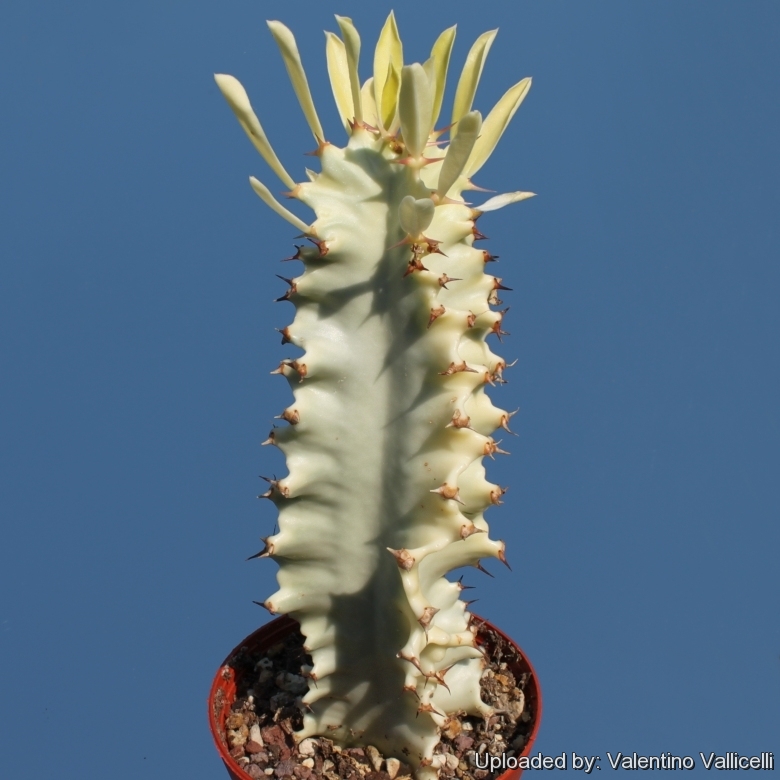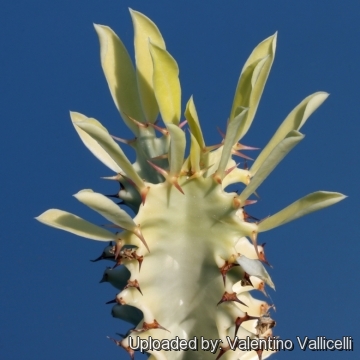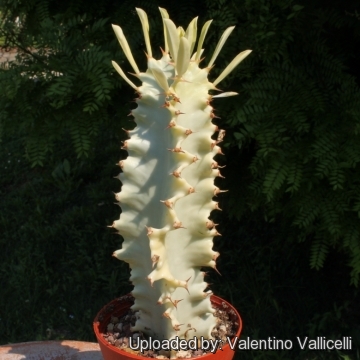




Your support is critical to our success.
- Encyclopedia of SUCCULENTS
- Encyclopedia Index
- Families
- Genera
- Species
- Euphorbiaceae
- Euphorbia
- Variegated
- Albinos
Since 4 Aug 2013

With its creamy-yellow stems it makes a wonderful indoors plant!
Origin and Habitat: Garden origin.
Synonyms:
Euphorbia erythraeae f. monstruosa cristata hort.
Accepted name in llifle Database:
Euphorbia erythraeae f. monstruosa hort.
Accepted name in llifle Database:
Euphorbia erythraeae f. variegata
Cultivars (1):
ENGLISH: Variegated Candelabra Spurge, Ghost Euphorbia
Description: Euphorbia candelabrum (erythraea) is a typical representative of large, tree-like Euphorbias that can grow up to 10 (or more) m tall (with a short trunk up to 90 cm in diameter), it is superficially similar to some new world Cacti (e.g. Cereus peruvianus) . The upright inverted umbrella shape ( broadly obconical crown) of this plant make it looks like a a branched organ-pipe or a candelabra (hence the name).
Stem: Stem stout, upright growing, cactus-like, slightly constricted at irregular intervals into segments, one trunk may produce more than150 branches as thick as a man's leg. They are deep green with a clean and smooth epidermis.
Ribs: Thick, undulate, 3-8 angled (but usually four-winged), dark-green, wavy when only in seedlings.
Spines: Paired, horn shaped, (may be absent in older plants)
Leaves: In the right climate (wet and warm at the same time) it will produce simple lancelate leaves near the top of each branch. These leaves are much larger and more prominent in the green form than in the variegated/yellow forms. On the seedling they are up to 40 mm long and 7 mm wide, but in the young shoots they are smaller.
Flowers: Yellow-green, in small clusters fo 3-6 above the pair of spines, fleshy, with 5 glands. Female flowers carry a three part pistil over a three part ovary, producing three or sometimes more seeds.
Fruits: green, 2-3 loculed, pea sized.
Remarks: It’s one of the more poisonous spurges. The latex which is very bitter and acrid contains diterpenes and is considered highly toxic.
Subspecies, varieties, forms and cultivars of plants belonging to the Euphorbia abyssinica group
 Euphorbia abyssinica J.F.Gmel.: It is a gigantic and very impressive treelike succulent that can grow to 10 m with several ascending dark green thick branches
Euphorbia abyssinica J.F.Gmel.: It is a gigantic and very impressive treelike succulent that can grow to 10 m with several ascending dark green thick branches Euphorbia erythraeae (A.Berger) N.E.Br.: This is the form from Eritrea that differs from “abyssinica” in the number and somewhat more fleshy character of the angles of the darker green stem and branches.
Euphorbia erythraeae (A.Berger) N.E.Br.: This is the form from Eritrea that differs from “abyssinica” in the number and somewhat more fleshy character of the angles of the darker green stem and branches. Euphorbia erythraeae f. monstruosa cristata hort.
Euphorbia erythraeae f. monstruosa cristata hort. Euphorbia erythraeae f. monstruosa hort.
Euphorbia erythraeae f. monstruosa hort. Euphorbia erythraeae f. variegata: Has cream, yellow and pale-green variegated stems.
Euphorbia erythraeae f. variegata: Has cream, yellow and pale-green variegated stems. Euphorbia erythraeae cv. Milk Totem: it is an odd cultivar with an overall creamy-yellow coloration.
Euphorbia erythraeae cv. Milk Totem: it is an odd cultivar with an overall creamy-yellow coloration.

Euphorbia erythraeae cv. Milk Totem Photo by: Valentino Vallicelli

Euphorbia erythraeae cv. Milk Totem Photo by: Valentino Vallicelli
Cultivation and Propagation: It is an easy species to grow that is suited for any well drained soil in full sun. But young plant are happy growing indoors, where they can easily reach the ceiling.
Growing rate: It is a moderately fast grower, but definitively slower growing than the standard species.
Soil and pots: Give the plant an airy growing medium which mainly consists of non organic material such us clay, pumice, lava grit, and only a little peat or leaf-mould. If plant becomes very red, this is a sign that the roots have not developed properly, so repot the plant with fresh growing medium. Like quite small pots, repott in very later winter, early spring. It will be content in its position and with its soil for years.
Watering: Water regularly during the active growing season from March to September. No water should ever be allowed to stand around the roots. Keep almost completely dry in winter.
Fertilization: Need a perfect fertilizer diet in summer. Use preferably a cacti and succulents fertilizer with high potassium content including all micro nutrients and trace elements or slow release fertilizer.
Wing tolerance: Only downside is from strong winds, the columns often smash into each other, causing permanent scarring... best to plant in such a location where winds are not a big issue.
Exposure: Best in filtered sun. It can tolerate moderate shade, and a plant that has been growing in shade should be slowly hardened off before placing it in full sun as the plant will be severely scorched if moved too suddenly from shade into sun.
Maintenance: Can be pruned for shape and branching.
Hardiness: Frost tender, frost free zones only.
Warning: All Euphorbias contain a white sap that can be irritating to eyes and mucous membranes. If contact is made with this white sap, take care to not touch face or eyes before washing hands with soap and water.
Propagation: It is easy to propagate by cuttings in late spring to summer, just take a cutting of the plant let it dry for 1 or 2 weeks and stuff it in the ground (preferably dry, loose, extremely well draining soil). It is better to wash the cut to remove the latex. Place the cutting in a warm, bright and slightly humid spot, to increase the building of new roots.
| Your Actions | |
|---|---|
| Back to Euphorbia index | |
| Back to Euphorbiaceae index | |
 |
Back to Succulents Encyclopedia index |
Privacy stantement - Terms and conditions - How to cite - About us - Feedback - Donate




